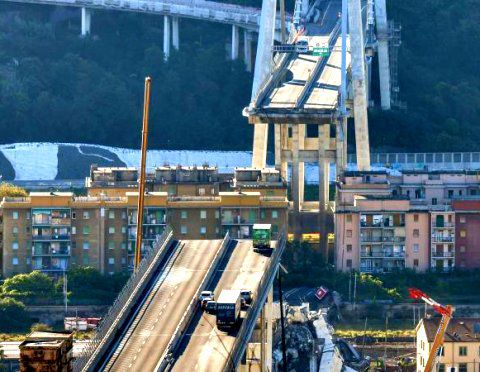QUESTIONS ABOUT THE COLLAPSE
GENE VIADUC |
|
The collapse "is not due to fatality," said the prosecutor of Genoa, Francesco Cozzi, who came on the scene, while the investigation had just begun. |
|
|
The numbers are likely to get heavier, probably remaining vehicles and passengers stranded in clumps of concrete and scrap. Italy will observe Saturday a day of national mourning and a solemn funeral ceremony will be organized for the victims. Before the Genova viaduct disaster, Italy had already experienced 10 bridge collapses in 5 years. Possible causes of this collapse: The 45-meter high viaduct that collapsed on Tuesday, August 14 at 11:40 am under heavy rain in Genoa in northern Italy, was nicknamed Morandi Bridge, named after its architect, and the building built in the 1960s had been the subject of much work in 2016. This building was built using experimental techniques in the late 1960s so engineers seek explanations after the Morandi viaduct collapsed. Design problem? Was this bridge built to support so much traffic? Clearly this exceptional work, built by one of the greatest Italian engineers of the twentieth century Riccardo Morandi, was made with prestressed reinforced concrete, a technique then very innovative and experimental: a prestressed concrete has the advantage of being very thin used there for light structures. The most delicate parts are the prestressed concrete shrouds, stretched between the aprons and pylons, which dampen each passage. 1.18 km long, 90 meters high, the viaduct of Genoa is built with a balance so delicate that a traffic overload could bring down the latter. Which was the case. Maintenance problem? In addition maintenance is more expensive than construction, punctual interventions are difficult to achieve even if in Genoa, the interview was followed. The issue of liability arose and the dealer company was singled out. It is the company Autostrade per l'Italia, which belongs to Atlantia, itself controlled to 30% by the Benetton family, who was in charge of the maintenance of this viaduct. Autostrade per l'Italia manages almost half of the country's 6,000 km motorway. In the face of criticism from the Italian government that confirmed Wednesday that it was going to revoke the concession of this company, the latter put forward Wednesday the seriousness of his supervision of the book. Indeed the section of Genoa was analyzed "at a quarterly pace by following legal standards and with additional checks of highly specialized devices ," she said. What has validated the Ministry of Transport. A construction fault? Consolidation work was in progress on the base of the viaduct. Roger Frank, an honorary professor at the École des ponts ParisTech, says: "This building is built from concrete and steel, with aging materials. Concrete is deteriorating. Steel is subject to corrosion. These are two well-known phenomena. But the evolution of this degradation depends on good factors, including climatic conditions and forces applied to the bridge. " Still, the Ministry of Transport has little investment in road infrastructure and the list of road disasters in Italy is long: The Genoa viaduct is the fifth bridge to collapse in Italy in five years. |
|
| Joanne Courbet for DayNewsWorld | |
 |
|




